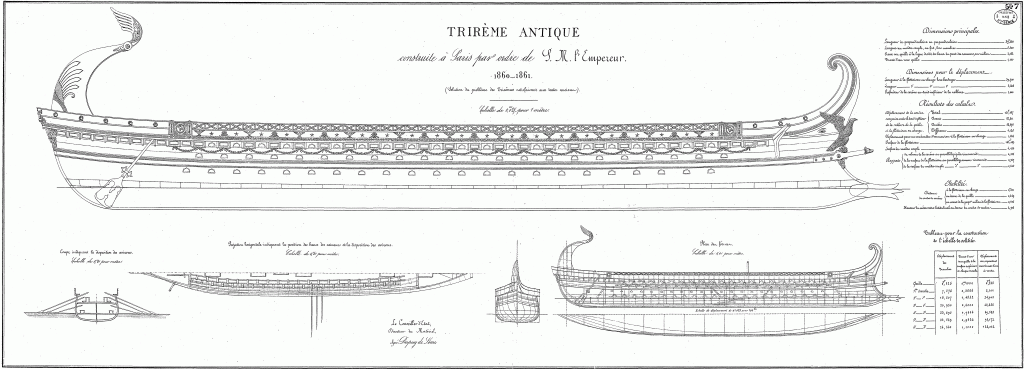The name trireme is derived from Latin: “tres remi,” quite literally, “three-oar” for the triple banks of oars it used for propulsion. The ships usually carried sails as well.
Developed some time around the 8th Century BCE, possibly by the Phoenitians, these warships were used by civilizations around the Mediterranean Sea. The prow was fitted with a metal ram which could be driven into the side of an enemy ship. Ships at the time were mostly built shell-first, that is the planking was shaped and then the skeleton of ribs were fitted later. This type of construction was especially prone to damage by ramming.
These plans are from the library of the French Ministry of Defense.

[…] to the popularity of our plans pages for the Ancient Trireme and the Gokstad Viking Longship, we’ve added two new ancient ship plans to our Oar-Powered […]
[…] du Génie Maritime from the archives of the French Ministry of Defense, which brings us an Ancient Trireme, a Sultan’s Caique, and an Ancient Galley, and our plan of the Gokstad Viking Longship […]
Just a possible correction to your description about the “ram” on old oar-powered ships. You claim that it was to punch holes in opponents’ ships. They may have been used for that, but Tim Severin found with his Jason ship that it helped tremendously to smooth out the waves around the ship so the oars could be more effective. That, I believe, was their main purpose.
Thanks! It’s always great to get additional information.
[…] du Génie Maritime from the archives of the French Ministry of Defense, which brings us an Ancient Trireme, a Sultan’s Caique, and an Ancient Galley, and our plan of the Gokstad Viking Longship […]
[…] to the popularity of our plans pages for the Ancient Trireme and the Gokstad Viking Longship, we’ve added two new ancient ship plans to our Oar-Powered […]
URL for tiff file seems to not be loading
Sorry about that. Thanks for the heads-up. Somehow the linked file appears to have been deleted. While I search for it, you can left-click on the plan image to open up the full-size plan file in GIF format. Right-click on that larger plan, choose “save image as” and select a location on your computer to which to download the file.